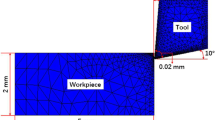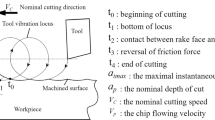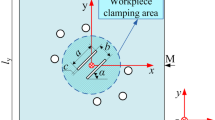Abstract
The aim of this study was to explore the influence of cutting parameters on the cutting performance of 7075-T651 aluminum alloy under different processing methods. Using finite element software, normal cutting, x-direction ultrasonic vibration cutting, y-direction ultrasonic vibration cutting, and elliptical ultrasonic vibration cutting processes were simulated with various values of the cutting parameters. The results showed that when the cutting speed was between 160 and 280 m/min, with the increase of the cutting speed, the main cutting force value under the four processing methods increases gradually. At 280–320 m/min, the main cutting force value of normal cutting showed a downward trend. The cutting force increased with the increase of feed and cutting depth. At the same time, the increase of cutting speed and feed increased the cutting temperature and the temperature of the blade-to-chip contact area. However, cutting depth had little influence on the temperature during the cutting process. When the cutting parameters changed, the cutting temperatures of the four machining modes were in the following order: elliptical vibration cutting > y-direction vibration cutting > x-direction vibration cutting > normal cutting. When the cutting speed and feed increased, the magnitude and depth of residual stress increased to a certain extent. As the cutting depth increased, the heat generated by the cutting increased, but most of the heat was carried away by the chips, resulting in lower influence of the thermal stress and phase changes on the residual stress.














Similar content being viewed by others
References
Ghosh A, Ghosh M (2018) Microstructure and texture development of 7075 alloy during homogenisation. Philos Mag 98(16):1470–1490
Cerchier P, Pezzato L, Moschin E, Coelho LB, Olivier MGM, Moro I, Magrini M (2018) Antifouling properties of different plasma electrolytic oxidation coatings on 7075 aluminium alloy. Int Biodeterior Biodegrad 133:70–78
Li GW, Chen FR, Han YQ, Liang YH (2018) Improving mechanical properties of pvppa welded joints of 7075 aluminum alloy by pwht. Materials 11(3):379
Navaser M, Atapour M (2017) Effect of friction stir processing on pitting corrosion and intergranular attack of 7075 aluminum alloy. J Mater Sci Technol 33(2):155–165
Alatorre N, Ambriz RR, Amrouche A, García C, Jaramillo D (2017) Fatigue crack growth in Al-Zn-Mg (7075-T651) welds obtained by modified indirect and gas metal arc welding techniques. J Mater Process Technol 248:207–217
Zhang T, Guo ZR, Yuan FP, Zhang HS (2018) Investigation on the plastic work-heat conversion coefficient of 7075-T651 aluminum alloy during an impact process based on infrared temperature measurement technology. Acta Mech Sinica 34(2):327–333
Geng QD, Wang W (2019) Experimental research on constant-current source ultrasonic strengthening characteristics of 7075-T651 aluminum alloy. J Mech Sci Technol 33(3):1203–1209
Senthil K, Iqbal MA, Chandel PS, Gupta NK (2017) Study of the constitutive behavior of 7075-T651 aluminum alloy. Int J Impact Eng 108:171–190
Marini M, Fontanari V, Bandini M, Benedetti M (2017) Surface layer modifications of micro-shot-peened Al-7075-T651: experiments and stochastic numerical simulations. Surf Coat Technol 321:265–278
Verma GC, Pandey PM, Dixit US (2018) Estimation of workpiece-temperature during ultrasonic-vibration assisted milling considering acoustic softening. Int J Mech Sci 140:547–556
Tian YB, Shen JQ, Hu SS, Wang ZJ, Gou J (2018) Effects of ultrasonic vibration in the CMT process on welded joints of Al alloy. J Mater Process Technol 259:282–291
Wang Y, Fu ZQ, Dong YH, Liu SG, Lu SQ (2018) Research on surface generating model in ultrasonic vibration-assisted grinding. Int J Adv Manuf Technol 96(9-12):3429–3436
Tabatabaei SMK, Behbahani S, Mirian SM (2013) Analysis of ultrasonic assisted machining (UAM) on regenerative chatter in turning. J Mater Process Technol 213(3):418–425
Zhang JJ, Wang DZ (2019) Investigations of tangential ultrasonic vibration turning of Ti6Al4V using finite element method. Int J Mater Form 12(2):257–267
Pei L, Wu HB (2019) Effect of ultrasonic vibration on ultra-precision diamond turning of Ti6Al4V. Int J Adv Manuf Technol 103(1-4):433–440
Tong JL, Wei G, Zhao L, Wang XL, Ma JJ (2019) Surface microstructure of titanium alloy thin-walled parts at ultrasonic vibration-assisted milling. Int J Adv Manuf Technol 101(1-4):1007–1021
Chen WQ, Zheng L, Teng XY, Yang K, Huo DH (2019) Finite element simulation and experimental investigation on cutting mechanism in vibration-assisted micro-milling. Int J Adv Manuf Technol 105(11):4539–4549
Zhou M, Hu LH (2015) Development of an innovative device for ultrasonic elliptical vibration cutting. Ultrasonics 60:76–81
Amini S, Soleimanimehr H, Nategh MJ, Abudollah A, Sadeghi MH (2008) FEM analysis of ultrasonic-vibration-assisted turning and the vibratory tool. J Mater Process Technol 201(1):43–47
Liu XF, Wu DB, Zhang JH (2018) Fabrication of micro-textured surface using feed-direction ultrasonic vibration-assisted turning. Int J Adv Manuf Technol 97(9-12):3849–3857
Maurotto A, Wickramarachchi CT (2015) Experimental investigations on effects of frequency in ultrasonically-assisted end-milling of AISI 316L: a feasibility study. Ultrasonics 65:113–120
Hosseinabadi HN, Sajjady SA, Amini S (2018) Creating micro textured surfaces for the improvement of surface wettability through ultrasonic vibration assisted turning. Int J Adv Manuf Technol 96(5-8):2825–2839
Lotfi M, Amini S, Aghaei M (2018) 3D FEM simulation of tool wear in ultrasonic assisted rotary turning. Ultrasonics 88:106–114
Shen Q, Liu ZQ, Hua Y, Zhao JF, Lv WY, Mohsan AUH (2018) Effects of cutting edge microgeometry on residual stress in orthogonal cutting of Inconel 718 by FEM. Materials 11(6):1015
Niu WL, Mo R, Liu GR, Sun HB, Dong XW, Wang GY (2018) Modeling of orthogonal cutting process of A2024-T351 with an improved SPH method. Int J Adv Manuf Technol 95(1-4):905–919
Johnson GR, Cook WH (1985) Fracture characteristics of three metals subjected to various strains, strain rates, temperatures and pressures. Eng Fract Mech 21(1):31–48
Dey S, Børvik T, Hopperstad OS, Langseth M (2006) On the influence of fracture criterion in projectile impact of steel plates. Comput Mater Sci 38(1):176–191
Akbari M, Buhl S, Leinenbach C, Wegener K (2016) A new value for Johnson Cook damage limit criterion in machining with large negative rake angle as basis for understanding of grinding. J Mater Process Technol 234:58–71
Hwang MC, Koo JY, Choi YK, Kim HJ, Kim JS (2017) Evaluation of surface quality and signal characteristics in milling process of Al7075-T651. Key Eng Mater 737:95–100
Schwankl M, Kellner R, Singer RF, Korner C (2013) The influence of sandblasting on the morphology of electroless deposited zinclayers on aluminum sheets. Appl Surf Sci 283:202–208
Wang B, Liu ZQ, Hou X, Zhao JF (2018) Influences of cutting speed and material mechanical properties on chip deformation and fracture during high-speed cutting of Inconel 718. Materials 11(4):461
Funding
This study was funded by the National Natural Science Foundation of China (Nos. 51705270 and 51575289).
Author information
Authors and Affiliations
Corresponding author
Ethics declarations
Conflict of interest
The authors declare that they have no conflict of interest.
Additional information
Publisher’s note
Springer Nature remains neutral with regard to jurisdictional claims in published maps and institutional affiliations.
Rights and permissions
About this article
Cite this article
Luo, H., Wang, Y. & Zhang, P. Effect of cutting parameters on machinability of 7075-T651 aluminum alloy in different processing methods. Int J Adv Manuf Technol 110, 2035–2047 (2020). https://doi.org/10.1007/s00170-020-05939-x
Received:
Accepted:
Published:
Issue Date:
DOI: https://doi.org/10.1007/s00170-020-05939-x




